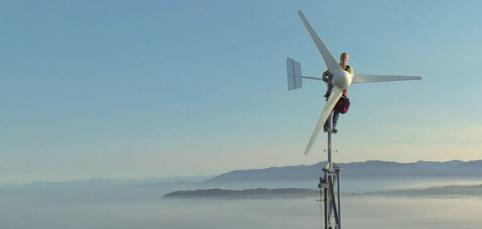With solar photovoltaic (PV) panel prices going lower and lower, solar arrays are quickly taking the place of small wind power projects and residential turbines. Is this the beginning of the end for small wind?
For many years, renewable energy enthusiasts in the northern areas of the United States favored small wind turbines, or a combination of wind and solar PV to produce electricity. Until recently, the installed cost of small wind turbines (100kW or under) was cheaper than that of PV However, the small turbine business has been plagued with problems since its inception. Many small turbines have been overhyped and under-performing. New machines have hit the market only to disappear at an alarming rate, leaving heart-broken consumers and red-faced dealers.
In a decade that has seen very few technical advancements in small wind systems, PV has shown huge advancements in technology, like micro-inverters, power-point tracking and increased efficiency. At the same time, Chinese PV manufacturers have driven solar panel prices down from $4 per watt in 2005 to less than $1 in 2015- in some cases under 50 cents (under 3 dollars per watt with all installation costs added.) Small wind turbine prices vary widely, with installed costs from $3- $6 per watt. Solar has the inherent advantage of being a solid-state technology, unlike wind turbines, which have a lot of moving mechanical parts. When parts move, they break, and all but a few wind turbines on the market have pretty dismal maintenance records, compared to PV.
In their latest issue, Home Power Magazine published their annual Wind Turbine Buyer’s Guide, even the long-time trade journal and advocate of small wind sounded apologetic about the prospects for buying small wind machines. Author’ Roy Butler and Ian Woofenden (one of the nation’s leading experts on small wind turbines) wrote that: “The people who are disappointed with their wind systems tend to have short towers, low-budget and mismatched equipment from newer companies or importers, and installation by inexperienced people. Most have unrealistic expectations of the wind resource and wind systems. These installations have high failure rates and low energy production. We’ve seen many systems that rarely generate any energy—and a system that costs even as little as $20,000 to as much as $100,000, but only generates a handful of kWh, is making very expensive electricity.”
Unlike solar PV, which has rapidly become integrated into the services provided by electrical contractors, small wind turbine installers are still generally “wildcatters,” start-up businesses looking to carve out a niche in a new energy market. Many lack the training to design a system properly, or they look to inexpensive, untested manufacturers for equipment. Home Power’s Buyer’s Guide does not single out any of these less-than-reputable companies, but they only include a handful of companies with under 10 or even 5 years of service. They make it clear that years in business is important. An elite few companies make completely reliable machines, like Bergey Windpower, who has a rock-solid reputation and nearly 40 years in the business.
There will always be off-grid applications for small wind turbines. Remote locations– particularly those with long, gray winters– can benefit greatly from using a solar along with wind, which works best on windy days, often when the sun is not shining. Coastal areas are also strong contenders fro small wind. On the upper end of the power-producing spectrum, large, utility scale wind projects are work-horses for producing a portfolio of diverse renewable energy sources. However, the window of opportunity for residential and small business wind turbines seems to be closing quickly. It would appear that only a major paradigm shift, or a huge jump in the price of silicon, will keep small wind on the map for residential customers.







